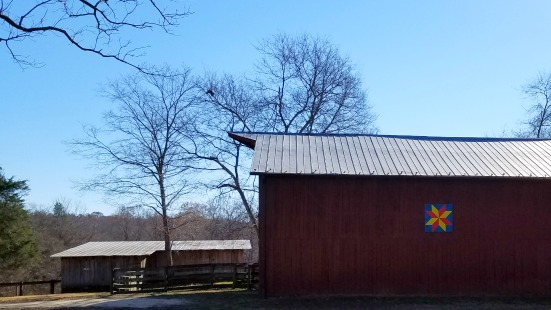You’ve maybe noticed in recent years the increasing popularity of barn quilts, colorful wooden quilt blocks displayed on the sides of barns, outbuildings, sheds, houses, and sometimes on their own posts. If you’ve stopped by the Cedarock Historical Farm in the past week, you’ve seen that we now have one too! The quilt block pattern featured on the Historical Farm’s barn is called the LeMoyne Star and was a popular quilt pattern in this area. There’s another new barn quilt up on the stage near the fishing pond as well, featuring a flag-inspired pattern.
The barn quilt movement is actually fairly young, started in 2001 in Adams County, Ohio. While painting decorations on barns in the Americas dates back to the mid-1800s the colorful wooden quilt panels you see today are a movement of the 21st century to celebrate rural areas and the history of both quilts and barn decoration. Original barn paintings sprang from the culture and folk art traditions of the Pennsylvania Dutch and are often known as Hex signs. These tended to feature stars or other simple patterns and were added for decorative purposes and good luck. Modern barn quilts are generally made from brightly painted plyboard and are 8 feet by 8 feet in size. These blocks are then attached to the barns.
The modern barn quilt movement began with Donna Sue Groves of Ohio, who wished to honor her mother and their Appalachian heritage with a painted quilt block pattern on their barn. Her idea evolved into a larger community project featuring 20 barn quilt patterns on a driving trail designed to attract visitors to the area. The first barn quilt was added to a nearby greenhouse and featured the Ohio Star pattern, marking the first barn quilt square of the American Quilt Trail. Later, in 2003, a Snail’s Trail pattern block was added to the Groves’ barn. Since this first trail, a national movement has emerged, with barn quilts and quilt trails now appearing in almost all of the United States and several Canadian provinces. Quilt trails are often community-wide movements, but many individuals also have their own barn quilts that are not part of designated trails.
Seventeen counties in NC are home to barn quilts that are part of designated quilt trails, mostly in the mountains. The nearest quilt trail to our area is in Randolph County, which features 29 different blocks. A map of this quilt trail can be found here. Quilt trails have become an important draw for tourists to rural regions and are a colorful celebration of our history. You can explore a map of barn quilts across the U.S. by state with this great interactive map on barnquiltinfo.com.
Sources: barnquiltinfo.com & heritagebarnquilts.com & Wikipedia’s “Hex sign” article

